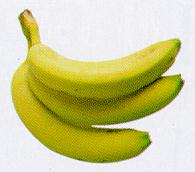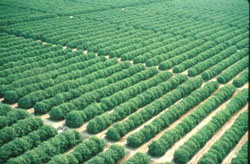|
*This page was produced as part of an assignment for an undergraduate course at Davidson College* GM Crops: A Farmer's Dream? |
|
Conferring Resistance Ramifications |
|
|
Monoculture: The End of the World's Food Supply? Those who consume the fruits of the farmer's labor often do not pause to think about how things were in the beginning. It is suspected that early farmers made use of approximately 200,000 species of plants, a startling number when compared to today's farming use of only about 100 plant species (Africa News Service, 2003). The farmers of the past, like the farmers of today, had to cultivate the species of plants that were easiest to tame, that produced the largest quantities of food, and that consumers were easily able to eat. This is observable if one were to examine the situation regarding the world's banana crop. One would see that the only species of banana widely used and consumed is the Cavendish (Africa News Service, 2003). The ancient banana was a horrid thing possessing inedible seeds and several pit-like breeding structures but thousands of years of farming has reduced it to the soft yellow fruit we all know (Africa News Service, 2003). Agriculture has had to operate this way for the financial well being of the farmer as well as to feed the growing hungry population and thus the ancient tradition has never stopped (Africa News Service, 2003). In order to make a living, the farmers of today must maintain vast expanses of the most prime strain of crop. There is a problem with this type of farming, a problem commonly known as monoculturing (Africa News Service, 2003).
Cavendish Bananas. *Permission Pending* (Bell, 2003) Why the fuss? How can GM help? Having a soft and plushy banana is indeed a delightful thing for a consumer, if not the only acceptable kind of banana. The problem comes when one looks at what was forcefully sacrificed by the plants in order to attain this form. The ancient inedible seeds and pit-structures were part of what made the banana a viable plant against the stresses of the environment (Africa News Service, 2003). Today, the Cavendish banana is sterile and requires the careful attention of their farmers to breed at all (Africa News Service, 2003). Those are the visible consequences of the conventional selection for the most economically favorable species of plant but what about at the genetic level? Just about half of the worlds total yield of bananas is destroyed by disease and insect pests and many never stop to wonder why the numbers are so high (Africa News Service, 2003). The Cavendish is the only species of banana that is grown and they are only allowed to breed, requiring the help of farmers, with other Cavendish (Africa News Service, 2003). The bananas are thus deprived of their genetic dynamism whereas these constraints are not imposed on insects and bacteria. Insects, bacteria, and other pathogens continue to make use of their natural reorganization of genetic material with subsequent generations. When a bacteria, virus, or insect targets the Cavendish as a host, the results are explosive because normal genetic variation is not there. The Cavendish is monocultured, that is, it is all only one type of species with homogenous genetic makeup, a genetic makeup that is necessary for farmers to continue making money and for consumers to continue eating (Africa News Service, 2003). If the crop does not have genetic variation, then all of the plants will be affected in the same disastrous way (Africa News Service, 2003). If there were heterogeneity, some of the banana plants would survive and pass on their traits to create a stronger insurgence against the pathogens (Africa News Service, 2003). Many scientists believe that the continued monoculturing of all of our crops is going to end in disaster with the world's defenseless food supply being destroyed by a super pathogen (Africa News Service, 2003). Though there are conventional ways of engineering resistance to disease and insect pests, they are entirely too inefficient for farmers to continue growing food with respect for both their own financial welfare and to feed the world's burgeoning population (Africa News Service, 2003). The only viable and available tool for possibly improving the detrimental situation generated by monoculture is genetic modification through biotechnological techniques (Africa News Service, 2003). Genetic modification would enable farmers to grow the same crops with inserted genetic traits to fight back against the pathogens that threaten the food supply while not changing the crop itself (Africa News Service, 2003). For instance, a Cavendish that is transgenically modified with something such as an insect antimicrobial peptide producing gene would be the same type of banana that destroys any bacteria that comes in contact with it (Gura, 2001).
An example of a monocultured crop field. (Sustainability Now, 2004) *Permission Pending*
Technical Concerns with Genetic Modification While genetic modification seems like the panacea for this situation, one must remember that there would be several other technical consideration with monoculturing. Among them is the fact that scientists and farmers alike would need to be careful that in engineering crops for a specific purpose not to create another form of a monoculture. If scientists were to release a genetically modified crop for commercial use carrying a certain gene to produce a type of viral resistance, this would only be a temporary fix. The virus would be stunted for a while but the crop again becomes a monoculture as the viral invader adapts to bypass the crop's new defenses. Researchers in the Zhao group have done experiments investigating possible solutions to the problem of creating another monoculture of genetically modified crops with promising results (Zhao et al., 2003). They found that if more than one variant of a pesticide producing gene were transgenically inserted into a crop, invading pathogens were much slower to become resistant to the internally generated pesticide (Zhao et al., 2003). Even genetic modification is not the cure-all for this problem as many perceive it, then. Though certainly as exemplified by the Zhao research, if care is taken and all technical issues considered, genetic modification can be nothing but a help in combating the effects of monoculture (Zhao et al., 2003). Questions or comments can be directed to matalbert@davidson.edu |


